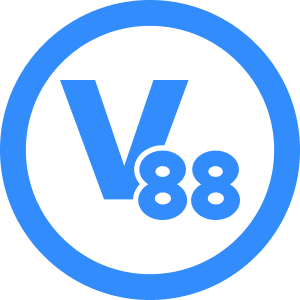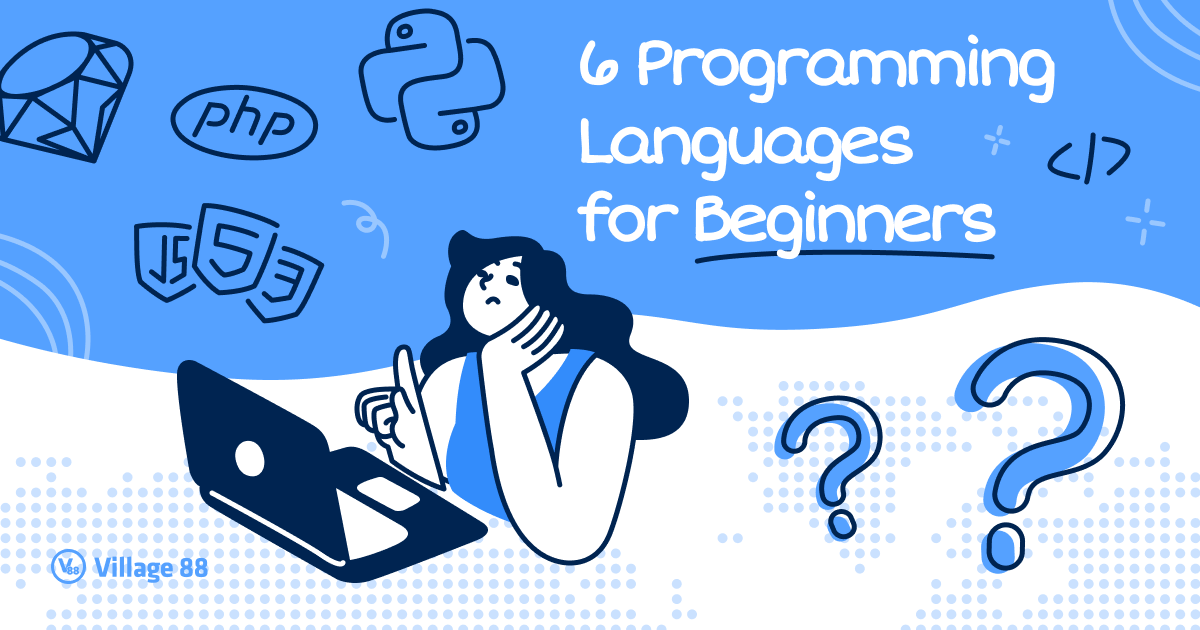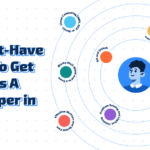Whether you’re looking to dive into the coding world as a new career or even as a hobby, the first thing you’ll have to do is decide which programming language you want to learn. When choosing a programming language to learn, consider what kinds of projects you intend to work on, what role you want to play in the project, or even how easy you want it to be.
There are hundreds of programming languages you could choose from, and it can be a little daunting to determine which would be best to learn as a beginner. Of course, there’s no one-size-fits-all answer that would be right for all. So. let’s discuss some of the essential front-end and backend programming languages you might want to consider at the beginning of your programming journey. We hope this guide we prepared will help you better understand six of the programming languages, what they are for, and be able to choose which one to learn first.
Front-end Programming Languages
The front-end is the interface users see and interact with in websites or software applications. It is where users perform key actions and access different sections and functionalities of the website or program.
Front-end developers ensure that the programming makes certain features available to users.
HTML
HTML or Hypertext Markup Language provides the basic structures of websites, the core of every website built. It is the starting point for anyone trying to make content for the web. HTML is the basic scripting language used by web browsers to create and render pages across the world wide web. The Hypertext allows users to click links and be redirected to other pages referenced by links.
HTML helps developers understand how to make things more accessible.
Advantages
- Easy to learn and use — Most developers are taught HTML before any other language as it’s one of the easiest to learn programming languages. The markup language that is HTML uses simple tags to identify different types of content and their purpose on the page. Plus, it has no issue with case sensitivity. It is possible to build an entire website using HTML.
- Free — Who doesn’t like free things? We certainly do, and many businesses worldwide rely on HTML to fulfill their website design requirements. HTML does not require users to buy anything or work with any external plugins or software to access its key features.
- Offers support for multiple browsers — as it’s the most commonly used language, HTML is supported by widely used browsers. No need for browser support concerns. You can optimize your HMTL websites for the browsers they can be loaded from.
Disadvantages
- Not Enough to Create Dynamic Pages — Modern times require modern websites. Sadly, using basic HTML is not enough to facilitate many of the features modern websites offer to users. It will be pretty challenging to add dynamic content to web pages using HTML alone. So, you will need to learn other programming languages such as CSS, JavaScript, or PHP.
- Content Display Limitations — Although you can build an entire website using HTML, it won’t be as appealing as others when it comes to displaying content. You will need CSS to make it more attractive to the eyes.
CSS
Cascading Style Sheets or CSS is one of the programming languages that developers use to style an HTML document or page by describing how the elements, like font styles and sizes, should be displayed on a screen, on paper when printed, and in other media. It is used to control how the HTML elements of the website should appear on the front-end of the page, the layout, formatting, and presentation of the website.
HTML is comparable to a wall, while CSS is the paint.
Advantages
- Time-saver — Developers can write CSS code once and reuse the same sheet across multiple HTML pages. You won’t have to write HTML tag attributes every time you need to style an HTML element.
- Faster Loading Speed — As CSS requires lesser codes, this means the lesser code, the faster the download time would be.
- Easy to maintain — CSS won’t require you to master loops, variables, and other concepts, unlike other programming languages. It’s pretty easy to pick up and has gained a reputation for being a simple front-end programming language. When you want to make a global change, simply change the style, and all the elements on all the web pages will automatically be updated.
Disadvantages
- Cross-browser issues — Although making CSS changes on a website can be easy, there is still the need to check CSS compatibility across browsers. CSS functions differently across browsers, so developers need to ensure that everything is changed similarly.
- Level Confusion — The CSS programming language has three levels: CSS, CSS2, and CSS 3. They all have slightly different specifications, and it can be a pretty confusing prospect for beginner developers.
JavaScript
JavaScript is an interpreted programming language with object-oriented capabilities. It is a flexible language that developers can use in front-end and back-end development. It is known to be lightweight and one of the most preferred programming languages in web development because of its flexibility. Social media giants like Google, Facebook, and Youtube use JavaScript in their infrastructure.
JavaScript lets users implement dynamic pages that display different content for different users while retaining the same design and layout. Such pages are implemented to show frequently changing information, like weather updates, stock prices, etc.
If you want to be both a front-end and back-end developer, consider learning JavaScript.
Advantages
- Less Server Load — JavaScript is a client-side language, which means it can be run immediately within the client-side browser reducing server demands.
- Simple — JavaScript is considered to be relatively simple to learn and implement.
- Interactive and Immediate Feedback — developers can create user interfaces that react when the users hover over a specific element. Users need not wait for the page to reload to know they missed entering something on their end.
- Works with other Programming languages — JavaScript is complementary to and integrated with other languages like Java, HTML, and CSS. You can use JavaScript, CSS, and HTML to build websites. JavaScript controls the behavior of different elements in web pages, while CSS controls presentation, formatting, and layout, while HTML provides the basic structure. Works with other Programming languages — JavaScript is complementary to and integrated with other languages like Java, HTML, and CSS.
Disadvantages
- Security Issues — Since JavaScript codes are executed on a user’s computer, it can lead to security concerns.
- No Networking Applications — There is no networking support available in JavaScript, so developers can’t use it for networking applications.
- Maintenance — it can be complex to maintain JavaScript when used as a backend.
- Browser Support — Browsers can interpret JavaScript differently, and it can be a challenge for some developers to create cross-browser code.
Backend Programming Languages
Backend development refers to all server-side operations and interactions between the database and browser. Backend programming languages are usually categorized into two major types: Object-Oriented and Functional Programming.
Object-Oriented Programming (OOP) emphasizes object or data formation instead of using logic. OOP is a commonly used approach when developers work on big and complex projects in teams.
Rather than the programming procedure, Functional Programming focuses more on declarations and results. It can be difficult for beginners to practice and complex to maintain and reuse.
Python
Python is a high-level interpreted object-oriented programming language and is one of the most popular for its compatibility with advanced technologies like Machine Learning, Data Science, the Internet of Things, etc.
Python is also known as a beginner’s language as It reads like English and is easy to understand for someone relatively new to programming.
Advantages
- Easy to Learn and Code — If you have a basic understanding of programming, you can learn Python’s syntax and start coding in a few hours.
- Object-oriented— You can define classes and objects to write structured code for your program or application because Python supports the programming paradigm of object-oriented programming.
- Reuse and Reduce — By using the concepts of OOP, coders can reuse the classes and functionalities easily. Doing this procedure reduces the lines of codes.
- Libraries — You will not need to write codes from scratch, as Python provides a wide range of libraries, including functionalities.
- Platform Independent — Python is known to be a portable and platform-independent programming language. Developers can run the same Python codes in Windows, Unix, Linux, etc.
Disadvantages
- Slower — Python can be slower than other programming languages because complex programs might take more time than normal to execute code.
- Memory Consumption — Due to data-type flexibility, Python’s memory consumption is also high, making it not the best choice for memory-intensive tasks.
- Version Confusion — Python has two major versions: Python 2.x series and Python 3.x series. The multiple versions of Python might cause problems, and the codes written in one version might cause errors in other versions, especially when you use libraries.
PHP
PHP is an interpreted HTML-embedded language. It is known for its simplicity, flexibility, and speed. PHP is generally used to design eCommerce sites, session tracking, and administer databases and dynamic content. Facebook is one social media site that relies on PHP to serve content. Wikipedia, Tumblr, Slack, Etsy, and many others also use PHP.
Advantages
- Simple and easy — PHP is known to be one of the simplest and most commonly backend programming languages, especially for web development. It is easier to learn as PHP has a strong ecosystem of resources for beginners, and it has a syntax that is more forgiving to beginners.
- Library Support — PHP has strong library support you can reuse. It provides you with the tools you are likely to need when developing an application or a website. Using the PHP library instead of writing codes to add features to the website can reduce development.
- Platform Independent — PHP can work for all operating systems and platforms.
- Faster Loading — PHP-based applications have a faster loading rate over slow internet speed compared to other programming languages.
Disadvantages
- Security Issues — Since it is open-source, PHP is not as secure.
- Extra Learning — You will need to learn the PHP framework to use the built-in PHP functionalities, or you’ll be forced to write additional codes.
- No change or modification is not allowed — PHP does not allow modification or change in the core behavior of the online applications.
Ruby
Ruby is another popular backend programming language that is high-level and has a simple syntax that is natural to read and easy to write. It is an open-source, object-oriented, general-purpose programming language.
Many developers use Ruby for its simplicity and productivity. Ruby requires less code to write, which requires lines of code for the most minor things. It is great for static websites, desktop applications, data processing, and automation tools.
Advantages
- Rails Framework — Ruby comes with its own server-side web application framework written in Ruby called Ruby on Rails or simply Rails.
- Easy changes — Most projects require extensive modifications, and those changes are easy to manage on Ruby.
- Fun to Code — Ruby’s simple syntax makes it one of the best programming languages for beginners learning the ropes of how the process works. Ruby can simplify complex concepts and give programmers a chance to work.
- Security — Ruby is one of the most trusted programming languages. Ruby stores and holds all objects based on reference rather than value to prevent any data from being overwritten or hijacked.
- Open Source and Flexible — Ruby is open-source, enabling developers to share codes. The open-source network of Ruby helps beginner programmers learn easier.
Disadvantages
- Slower — The runtime speed of Ruby is comparatively slower compared to other languages.
- Relatively New — Compared to other programming languages, Ruby is fairly new and has its own unique coding language. It can be a disadvantage as programmers would need considerable time to learn the programming language before using it for programming.
- Development — Ruby’s development and updates are slower compared to other programming languages. The latest version of Ruby is 3.1.2, while PHP, which was developed almost simultaneously, is in its 7.4 version.
So, Which is the Best Programming Language for Beginners?
While there will be things you will be considering when choosing, programming will be hard no matter which you choose. Like learning any other language, learning a programming language is guaranteed to be challenging, even frustrating, when you’re just getting started and trying to get good at it. So consider this mini-guide:
- If you’re just barely beginning to learn to program: HTML and CSS
- If you want to try front-end and backend development: JavaScript
- If you’re looking for something easy to pick up: Python
- If you’re looking to develop web applications: Ruby
- If you plan to build eCommerce sites or Social Media apps: PHP
Learn How to Code with Us!
Whether you’re planning to be a front-end or back-end developer, remember to take things slow. Don’t rush. As they say, good things take time. So, take your time and try to enjoy learning.
Self-study has its advantages, but there is so much more you can learn with a mentor to guide you along the way. Village 88 offers training with a world-class and proven effective curriculum taught by experienced mentors, exclusively for CS/IT grads in the Philippines, for free.
You can join Village 88’s Free Online Training. We offer free training for fresh graduates and non-graduates with coding backgrounds. The training covers five out of six of these programming languages. Other industry-relevant technologies are also part of the training. This training is absolutely free, without hidden charges or future salary deductions when you land a job. No cost, no fee, just free.
We’d love to hear from you! You can check out our website to register or learn more about us. You can also contact us on our FB page for other inquiries. Together, we can achieve your programming goals! We’d love for you to join us.






It agree, rather useful phrase
Another essential issue to remember is always to use an elegant clothing. Chinese ladies like to dress up and are more likely to answer favorably into a person sporting pricey clothes. However, if you’re not at ease with using pricey clothes, you are able to prefer to use some thing informal. But remember that Oriental ladies don’t like guys in denims or t-tops with exotic designs.